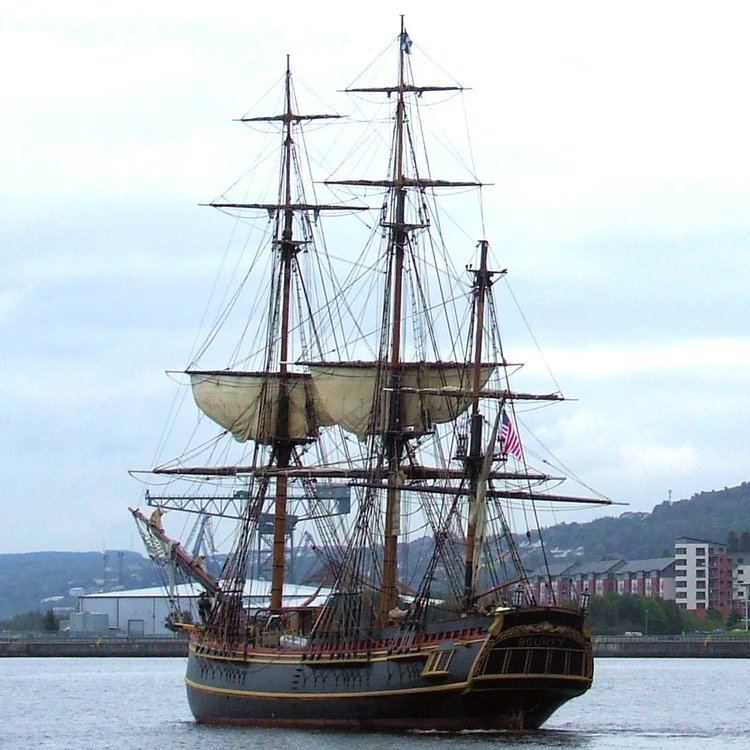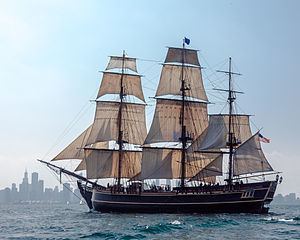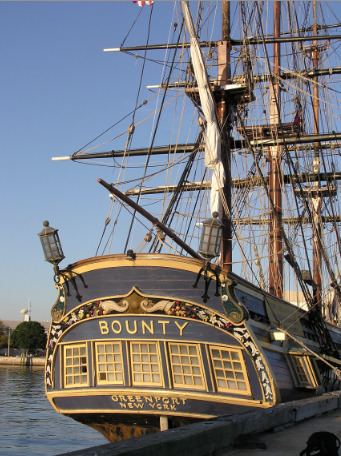Tonnage 409 GT181 NT Launched 1960 Beam 9.6 m | Height 111 ft (33.8 m) Length 55 m Builder Smith & Rhuland | |
 | ||
Owner HMS Bounty Organization LLC Fate Sunk off the coast of North Carolina during Hurricane Sandy on 29 October 2012 | ||
Bounty was an enlarged reconstruction of the original 1787 Royal Navy sailing ship HMS Bounty. Built in Lunenburg, Nova Scotia in 1960, she sank off the coast of North Carolina during Hurricane Sandy on 29 October 2012.
Contents
The tall ship was often referred to as HMS Bounty, but was not entitled to the use of the prefix "HMS" as she was not commissioned into the Royal Navy. Here "HMS" is treated as part of the popular name, and not as a ship prefix.

MGM

Bounty was commissioned by the Metro-Goldwyn-Mayer film studio for the 1962 film Mutiny on the Bounty. She was the first large vessel built from scratch for a film using historical sources. Previous film vessels were fanciful conversions of existing vessels. Bounty was built to extrapolated original ship's drawings from files in the British Admiralty archives, and in the traditional manner by more than 200 workers over an 8-month period at the Smith and Rhuland shipyard in Lunenburg, Nova Scotia. To assist film-making and carry production staff, her general dimensions were greatly increased resulting in a vessel nearly twice the tonnage of the original . While built primarily for film use, she was fully equipped for sailing because of the requirement to move her a great distance to the filming location. Two other well known reproductions were built at the yard subsequent to Bounty; Bluenose II and HMS Rose.

Bounty was launched on 27 August 1960. Crewed by Lunenburg fishermen and film staff, the vessel sailed via the Panama Canal to Tahiti for filming. Bounty was scheduled to be burned at the end of the film, but actor Marlon Brando protested, so MGM kept the vessel. After filming and a worldwide promotional tour, the ship was berthed in St. Petersburg, Florida as a permanent tourist attraction, where she stayed until the mid-1980s.

The ship was also featured in an episode of Flipper (1964 TV series) titled "Flipper and the Bounty" which aired 11 December 1965.
The ship was featured in the 1983 film, Yellowbeard, a comedy about pirates starring Graham Chapman, Peter Boyle and many other comedic stars, including Marty Feldman in his final role before suffering a heart attack during production.
In 1986, Ted Turner acquired the MGM film library and Bounty with it. The ship was used for promotion and entertainment, and was used during the filming of Treasure Island with Charlton Heston and Christian Bale in 1989.
Fall River, Massachusetts
In 1993, Turner donated the ship to the Fall River Chamber Foundation, Inc, which established the Tall Ship Bounty Foundation, Inc to operate the ship for educational "adventures" as well as a tourist attraction and celebrity promoter of Fall River, Massachusetts. Bounty summered in New England waters operating out of the Heritage State Park facilities in Fall River and wintered in Florida operating out of the St. Petersburg Pier.
The ship was booked to appear in several feature films in the mid-1990s, such as a remake of the 1935 film Captain Blood, starring Errol Flynn, and a film about Anne Bonny, an 18th-century female pirate. Both projects were shelved before production began. The ship was set to appear in the 1997 Steven Spielberg film Amistad, but before her scenes were shot in Newport, Rhode Island, filming of the slave ship rebellion at the beginning of the film was moved to Puerto Rico and California. However, the ship did appear in several documentaries during her eight-year stay in Fall River.
In the mid-1990s, Marlon Brando, star of the 1962 version of Mutiny on the Bounty, showed interest in using the ship for a project in the area of his island in the South Pacific. However, he was surprised at what it cost to operate a ship with a crew on a weekly basis, and he passed on the idea.
While under ownership of the Tall Ship Bounty Foundation, the ship went into dry-dock twice and had major improvements to the ships ribs and planks. During the second dry docking, Captain Robin Walbridge decided to permanently remove the copper cladding and in its place applied marine anti-fouling paint to repel the insects that bore into the wood. Due to lack of commitment to long term funding by the private and public sectors, the trustees of the Tall Ship Bounty Foundation, Inc. determined it was time to put the ship up for sale. Due to cash flow problems all the crew were terminated and volunteers kept a watch over Bounty at its dock at Heritage State Park. On 15 March 2001, the ship was sold to the HMS Bounty Foundation.
In 2005, while moored in St. Petersburg, Bounty was the shooting location of the "pornographic action-adventure" film Pirates.
Restoration
The ship's declining condition caused the vessel to temporarily lose her Coast Guard license, but Bounty was restored. The vessel's bottom planking was replaced and repair as required at the Boothbay Harbor Shipyard in 2002. Moored in her winter home in St. Petersburg, Florida, she again became available for charter, excursions, sail-training, and movies, including Pirates of the Caribbean: Dead Man's Chest and The SpongeBob SquarePants Movie In April 2006, Bounty returned to Boothbay Harbor for further refit including repairs to her forward sections and decks. Following this work, Bounty was scheduled to repeat the famous voyage of the original Bounty.
During the 2006 refit, the ship was virtually rebuilt to make her appearance more similar to that of the original HMS Bounty, and make her more suitable for service as a sail training vessel. Her lower decks were cleared of most of its 18th-century-style furnishings and living spaces, including the Great Cabin, the galley, and the officers' quarters. The color of the ship's hull was changed from ocean-blue to black and dark green.
Post-restoration, thieves, and sale attempt
In August 2007, Bounty had just completed a US $3 million restoration and was making a seven-week UK tour prior to embarking on a world tour via South Africa and New Zealand to Pitcairn (home to the original Bounty descendants) and Tahiti. The UK ports tour included a visit to Maryport, Cumbria, the birthplace of mutiny leader Fletcher Christian. On Saturday 12 September 2009, the ship was berthed at Custom House Quay in Greenock, Inverclyde, Scotland. At about 04:10 BST thieves targeted the ship and stole a small sum of cash, several items of clothing with Bounty's insignia, a survival suit, a book, a life ring and an American flag. The items were later recovered nearby.
Bounty's owners had offered her for sale since 2010. The ship was for sale as of 2012 for US$4.6 million. In winter of 2012, the ship was in San Juan, Puerto Rico. She took part in the Tall Ships gatherings 2012, and was in Halifax, Nova Scotia in July 2012. On 12 August she was docked at Belfast, Maine. On 3 September, Bounty sailed from Gloucester, Massachusetts to Eastport, Maine. After a stop at Maine Maritime Academy in Castine, she pulled into Boothbay Harbor for dry dock and maintenance. She was relaunched from the Boothbay Harbor Shipyard on 17 October 2012. Bounty left Boothbay bound for New York City early 21 October 2012.
Loss
On 25 October 2012, the vessel left New London, Connecticut, heading for St. Petersburg, Florida, initially going on an easterly course to avoid Hurricane Sandy.
The initial request for Coast Guard assistance was sent in an email by the captain to the vessel's organization. At about 8:45 pm EDT, the organization relayed the request to Coast Guard Sector North Carolina about Bounty's situation. Shortly thereafter the Bounty crew activated one of Bounty's EPIRB beacons. Walbridge had reported the ship was taking on water, and the crew was preparing to abandon ship. Afterwards Bounty lost electrical power due to water flooding the starboard generator.
This information was sent to a Coast Guard C-130 rescue airplane crew that was stationed in North Carolina at Raleigh-Durham Airport. The ship's location was given as roughly 90 miles southeast of the Outer Banks in the vicinity of a feature on the ocean floor known as the Hatteras Canyon. The C-130 rescue plane underwent equipment outages on its rescue flight, including its anti-icing system and its weather radar. This caused the pilot (Lieutenant Wes McIntosh) and the co-pilot (Mike Myers) to conduct the search at approximately 500 feet (150 m) AMSL in an attempt to locate the vessel visually, around midnight and with poor visibility. Shortly after midnight on 29 October, the stricken vessel was discovered.
The USCG aircraft made radio contact with John Svendsen, Bounty's first mate, as the C-130 circled the ship in the early morning hours. Bounty was listing at about a 45 degree angle on its starboard side. As the C-130 crew radioed instructions to Bounty, the plane circled for hours while preparations were made. Meanwhile, helicopter crews from Elizabeth City were instructed to prepare for a very difficult rescue operation. At 4:45 am, Svendsen radioed to the C-130 that the ship was sinking and the crew needed immediate assistance. McIntosh flew the plane lower and readied his crew to drop life rafts and supplies. With the plane short on fuel, the C-130 dropped liferafts but had to leave the vessel and crew on their own in rough seas and 50-knot (93 km/h; 58 mph) winds. It would be more than an hour until the first Jayhawk helicopter arrived on the scene to begin the dangerous rescue attempt around dawn. One member of the Coast Guard crew received major injuries during the rescue.
Vice Admiral Parker, USCG, reported the ship had sunk and fourteen people had been rescued from liferafts by two rescue helicopters. The storm had washed the captain and two crew overboard—one of the latter had made it to a liferaft, but the other two were missing. They wore orange survival suits complete with strobe lights, thus rescuers had some hope of finding them alive. Claudene Christian, one of the two missing crew members and who claimed to be related to HMS Bounty mutineer Fletcher Christian, was found by the Coast Guard. She was unresponsive, and later pronounced dead at a hospital.
The other missing crew member was long-time captain Robin Walbridge. Raised in Montpelier, Vermont, Walbridge later moved to St. Petersburg, Florida. He was a field mechanic on houseboats who worked his way up to obtaining a 1600-ton license in 1995, when he began working as a Bounty crew member. Search efforts for Walbridge continued over an area of 12,000 square nautical miles (41,000 km2; 16,000 sq mi) until they were suspended on 1 November 2012.
A formal investigation into the sinking was ordered by USCG Rear Admiral Steven Ratti on 2 November 2012. An inquiry into the sinking was held in Portsmouth, Virginia from 12 to 21 February 2013; at which it was concluded that Captain Walbridge's decision to sail the ship into the path of Hurricane Sandy was the cause, and the inquiry found this to have been a "reckless decision". The loss of the ship prompted the USCG to conduct a review of the events and decisions leading to the loss of the ship.
